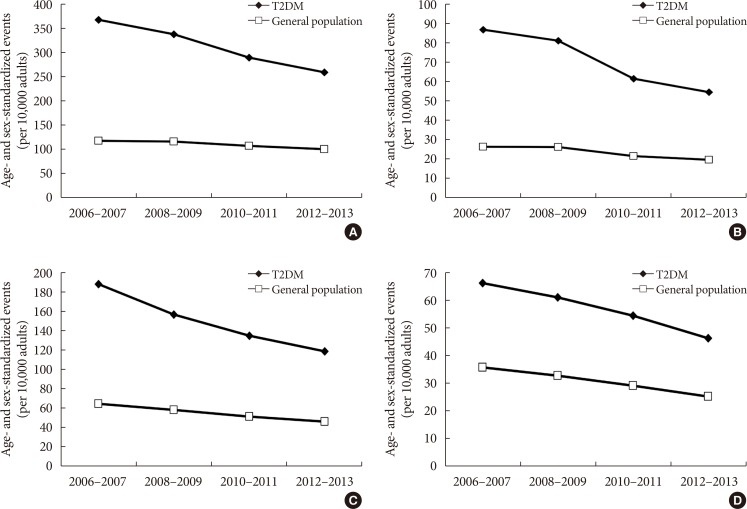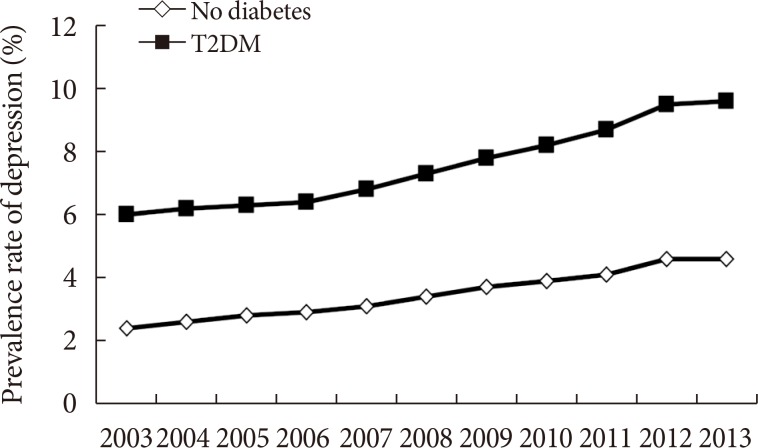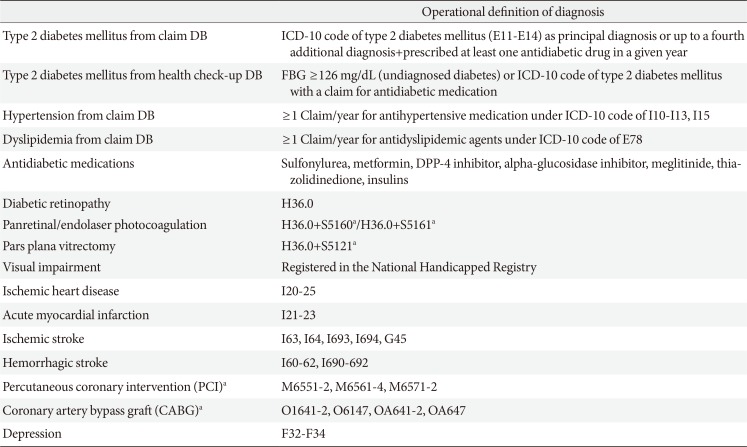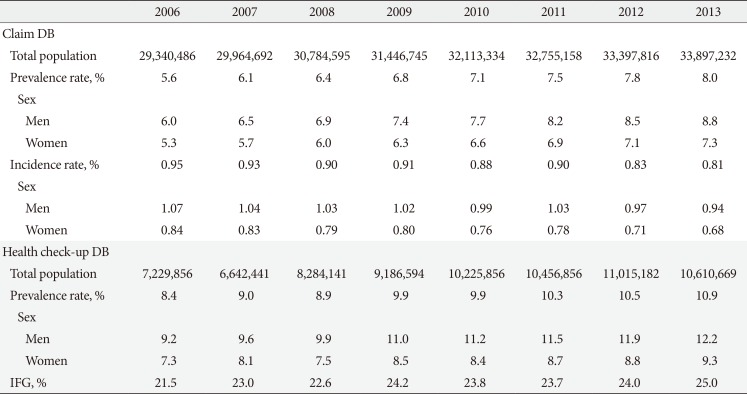Abstract
Korea's National Healthcare Program, the National Health Insurance Service (NHIS), a government-affiliated agency under the Korean Ministry of Health and Welfare, covers the entire Korean population. The NHIS supervises all medical services in Korea and establishes a systematic National Health Information database (DB). A health information DB system including all of the claims, medications, death information, and health check-ups, both in the general population and in patients with various diseases, is not common worldwide. On June 9, 2014, the NHIS signed a memorandum of understanding with the Korean Diabetes Association (KDA) to provide limited open access to its DB. By October 31, 2017, seven papers had been published through this collaborative research project. These studies were conducted to investigate the past and current status of type 2 diabetes mellitus and its complications and management in Korea. This review is a brief summary of the collaborative projects between the KDA and the NHIS over the last 3 years. According to the analysis, the national health check-up DB or claim DB were used, and the age category or study period were differentially applied.
According to the recently published report of the Korea National Health and Nutritional Examination Survey 2011, which is a cross-sectional health surveillance program on a nationwide scale, 4 million Koreans aged 30 years or older have diabetes, and the prevalence of diabetes was 12.4% [12]. In 2016, diabetes was ranked as the sixth cause of death and the most common cause of renal replacement therapy in Korea [34]. According to the annual report on Health Insurance Statistics by the Korean National Health Insurance Service (NHIS) and the Korean Health Insurance Review & Assessment (KHIRA) Service, diabetes ranked third in medical expenses as a single disease in Korea in 2015 [1].
The systematic care for chronic illnesses with large socioeconomic
and health burdens such as type 2 diabetes mellitus (T2DM) is a very important health issue. For the establishment of management policies and improvement in the quality of care of this chronic metabolic disease, an accurate analysis of the current nationwide database (DB) on health information would be an initial step. The Korean NHIS program covers the computerized DB containing all of the claim data, including patient demographics, drug prescriptions, diagnostic codes for the disease coding system, the International Classification of Diseases (ICD), insurers' payment coverage, patients' deduction, and claimed treatment details [56]. The NHIS DB represents the entire Korean population; therefore, it can be used in a population-based nationwide study for T2DM in Korea.
Among the total datasets of the NHIS DB, we used qualifications, claims, the health check-up DB, and death information. The claim DB consists of four categories, including general information on specifications, consultation statements, diagnosis statements classified by the International Classification of Diseases 10th revision (ICD-10), and detailed information about prescriptions [567]. To extract the health information of the general population, we used the DB from the general health check-up. Due to the inevitable limitations of the claim DB, T2DM and related diseases were defined operationally (Table 1). To validate the information accuracy, an expert committee from the Korean Diabetes Association (KDA) reviewed the DB regularly during this analysis. The committee decided the suitability of the dataset and reviewed the results of the analysis.
Among all of the beneficiaries of the NHIS, retrospective data for adult patients with T2DM aged 30 years or older were extracted from January 2002 through December 2013. Patients were classified as having T2DM when they had at least one service claim with a diagnosis of T2DM based on ICD-10 codes E11, E12, E13, or E14, as either the principal diagnosis or the first to fourth additional diagnosis, and were prescribed at least one antidiabetic drug anytime in a given year to exclude prediabetes or non-diabetic subjects [7]. Type 1 diabetes mellitus, gestational diabetes, and subjects with missing data were excluded. All of the ambulatory visits and any reason for hospitalizations with ICD-10 codes of T2DM were included. Using the national health examination DB, subjects with fasting blood glucose levels ≥126 mg/dL without a claim for antidiabetic medication under the ICD-10 code (undiagnosed diabetes) were also considered as having diabetes. This study was approved by the Institutional Review Board of the Korean National Institute for Bioethics Policy (P01-201504-21-005). Informed consent was exempted by the board.
From this analytical process, the prevalence of T2DM based on the claim DB, trends in diabetic complications and the prescription patterns of antidiabetic drugs, and depression in Korean adult patients with T2DM are summarized in this report.
We defined T2DM by the NHIS claim DB only if the subjects had visited a healthcare institution and had antidiabetic medications or by the health check-up DB if they showed high fasting glucose levels (≥126 mg/dL) without a claim for antidiabetic medication under the ICD-10 code of T2DM (Table 1). Based on this claim DB, the prevalence of T2DM increased 0.2% to 0.5% annually, from 5.6% (1,655,495 patients) in 2006 to 8.0% (2,720,777 patients) in 2013 [8]. The incidence of T2DM was 0.81% in 2013 and increased with age [8]. The incidence of T2DM was 1.4 times higher in men than in women (Table 2). The prevalence of impaired fasting glucose (glucose levels of 100 to 125 mg/dL without antidiabetic medications or an ICD-10 code of T2DM in the health check-up DB) increased from 21.5% in 2006 to 25.0% in 2013 (Table 2).
In addition, hypertension (62.5% vs. 16.9%) and dyslipidemia (45.9% vs. 9.7%) were more prevalent in patients with T2DM than in non-diabetic adults, respectively. In contrast, the control rate of hypertension from the health check-up DB was significantly lower in patients with T2DM compared to non-diabetic subjects (75.8% vs. 87.1%, P<0.001) [8].
We analyzed the trends in the prescription patterns of antidiabetic agents in T2DM, such as sulfonylurea (SU), metformin, α-glucosidase inhibitor, meglitinide, dipeptidyl peptidase-4 (DPP-4) inhibitor, thiazolidinedione, and insulin. Sodium-glucose co-transporter-2 inhibitor, which was introduced in 2015, and glucagon-like peptide-1 receptor agonist, which had limited insurance coverage, were not included in the analysis.
Among 870,000 patients with T2DM who were treated with antidiabetic agents, SU was the most commonly used (87.2%), and metformin held the next rank (52.9%) in 2002 [7]. During the past decade, the use of metformin increased steadily to 80.4% of total antidiabetic drug prescriptions and was the most frequently prescribed antidiabetic agent in Korea in 2013. The Clinical Practice Guidelines of the KDA recommend that active lifestyle modification and the appropriate use of antidiabetic agents are needed following the initial diagnosis of T2DM. Metformin is the preferred initial oral antidiabetic agent [910]. Therefore, the proportion of metformin use is expected to be maintained constant at the current level.
Since the introduction of DPP-4 inhibitors in Korea at the end of 2008, its use has increased dramatically, comprising one-third of the Korean market share (38.4%) in 2013. The prescription of insulin increased to 19.1% of all patients with T2DM in 2008 and then was maintained as a constant over time (Table 3) [7].
Among antidiabetic prescriptions, the proportion of monotherapy declined from 58.4% in 2002 to 39.5% in 2013 [7]. In contrast, dual and triple combination therapy steadily increased from 35.0% and 6.6% in 2002 to 44.9% and 15.5% in 2013, respectively (P for trend <0.0001) [7]. In 2002, SU with metformin was the most frequently used dual therapy combination (68.7%). However, in 2013, SU with metformin (41.7%) and metformin with DPP-4 inhibitors (32.5%) dual combination therapies were the most frequently prescribed. According to the increased number of patients with T2DM, total antidiabetic pharmacy expenditures dramatically increased from 83 billion won in 2002 to 582 billion won in 2013 [7]. In addition, the mean payment per patient per year for antidiabetic medication was about 90,000 won in 2002 and 180,000 won in 2013.
Diabetic retinopathy (DR), which is one of the chronic diabetes-related vascular complications, is a troublesome complication and significantly increases medical costs [1112]. In Korea, there was a steady increase in the prevalence of DR, from 14.3% in 2006 (n=237,267) to 15.9% (n=431,964) in 2013 [13]. The prevalence of DR was higher in female patients than in males. The proportion of patients who underwent an annual fundus examination improved from 24.3% in 2006 to 30.0% in 2013. In other words, more than two-thirds of patients with T2DM did not have their fundus checked in a year. However, the proportion of patients with T2DM who received laser treatments or underwent vitrectomy constantly decreased over the last decade. In 2006, among the patients with DR, 2.4% underwent vitrectomy and 11.4% received laser treatments, compared to 1.7% and 6.9%, respectively, in 2013 (P<0.0001) [13]. Accordingly, the percentage of patients with visual impairment who had a best-corrected visual acuity of <0.1 among DR patients decreased from 2.0% (4,820/237,267) in 2006 to 0.8% (3,572/431,964) in 2013 (Fig. 1) [13].
A long-standing hyperglycemia, insulin resistance, hypertension, and dyslipidemia cause various metabolic and molecular changes within the myocardium and coronary vessels [14]. These factors play pivotal roles in the development of cardiac dysfunction, diabetic cardiomyopathy, or cardiovascular (CV) disease, although multiple complex mechanisms and contribute to its pathogenesis [1415].
Using the claim DB, six diabetes-related CV complications, including ischemic heart disease, acute myocardial infarction (AMI), ischemic stroke, hemorrhagic stroke, percutaneous coronary intervention, and coronary artery bypass graft, were investigated (Table 1). In the population with T2DM over 30 years and older, the age and gender standardized rates of the above six CV outcomes decreased in Korea during the study period. Among them, hospitalization from AMI (−37.3%) and ischemic stroke (−37.0%) dramatically decreased between 2006 and 2013 in T2DM [16]. In the general population without T2DM, hospitalization from hemorrhagic stroke (−29.5%) and ischemic stroke (−28.9%) represented the largest drops. Moreover, the relative decrease in all six CV complications was profound in adults with T2DM compared to those in the general population [16]. But subjects with T2DM continued to show a two- to six-fold higher risk of hospitalization due to major CV complications (Fig. 2) and CV interventions (Fig. 3) than people without T2DM. We suggest this reduced rate of CV outcomes in patients with T2DM seems to be related to the recent trend of improved control rates of hypertension, dyslipidemia, smoking cessation, and glycemic control in T2DM in Korea [17].
Previously, the prevalence of depression in patients with T2DM in Korea has been reported as high as 22.6% to 28.8% [1819]. In the analysis using the NHIS DB, depression in T2DM was defined as both T2DM and depression (ICD-10 code of F320-349) with at least one prescription for antidepressants (Table 1) [20].
According to the analysis of the NHIS DB from 2003 to 2013, the annual prevalence rates of depression consistently increased both in T2DM and the general population without T2DM (Fig. 4) [20]. During the study period, the prevalence rate of depression in T2DM was about two-fold higher compared to the general population (9.6% vs. 4.6% in 2013). In addition, T2DM patients with depression demonstrated a significantly higher mortality risk than those without depression, especially in males and younger age groups [20]. The 10-year mortality rate in T2DM with depression was 1.4-fold higher compared to T2DM without depression, particularly for those in their 30s and 40s [20].
There are some limitations in this analysis [567]. First, because health insurance coverage is confined to the allowable range of the recommendations for antidiabetic drug combinations made by the KHIRA Service in Korea, prescriptions not covered by health insurance were missed in this analysis. In addition, the NHIS DB does not contain uninsured prescriptions or over-the-counter drugs. Second, medical aid (MA) beneficiary information has been incorporated into a single NHIS DB only since 2006; therefore, the NHIS DB included only information on NHIS beneficiaries, not MA beneficiaries, from 2002 to 2005. Third, due to the characteristics of the claim DB, discrepancies between the actual diagnosis and claim data might be possible. Our reported number may not be the actual number of diabetic patients because not every patient who had T2DM visited a clinic or used antidiabetic medication, and not all patients with prescriptions visited the pharmacy and obtained the medication. Fourth, this analysis relied only on claims data; we therefore could not obtain clinical information on glucose or glycosylated hemoglobin levels, diabetic duration, or reasons for nonadherence.
Despite steady improvements in screening, early detection of diabetes, and diabetes care in Korea, the absolute number of patients with T2DM remains high. A large and relevant economic burden remains. Considering the importance of T2DM as a national health issue, the accurate estimation of the use of antidiabetic medications and understanding of diabetes-related complications would be valuable information for the establishment of health policies and the setting of intervention target priorities. Healthcare professionals, academic expert groups such as the KDA, and government agencies should work together to find solutions for the health promotion to Korean patients with T2DM. From this respect, collaborative research by the NHIS and the KDA would be a good first step.
ACKNOWLEDGMENTS
This work was performed with the cooperation of the National Health Insurance Service (NHIS), and the Korean Diabetes Association. The National Health Information Database made by NHIS was used (No. NHIS-2015-4-008).
References
1. Jeon JY, Ko SH, Kwon HS, Kim NH, Kim JH, Kim CS, Song KH, Won JC, Lim S, Choi SH, Jang MJ, Kim Y, Oh K, Kim DJ, Cha BY. Taskforce Team of Diabetes Fact Sheet of the Korean Diabetes Association. Prevalence of diabetes and prediabetes according to fasting plasma glucose and HbA1c. Diabetes Metab J. 2013; 37:349–357. PMID: 24199164.

2. Jeon JY, Kim DJ, Ko SH, Kwon HS, Lim S, Choi SH, Kim CS, An JH, Kim NH, Won JC, Kim JH, Cha BY, Song KH. Taskforce Team of Diabetes Fact Sheet of the Korean Diabetes Association. Current status of glycemic control of patients with diabetes in Korea: the fifth Korea National Health and Nutrition Examination Survey. Diabetes Metab J. 2014; 38:197–203. PMID: 25003073.

3. Statistics Korea. Statistical database 2016. update 2017 Oct 25. Available from: http://kostat.go.kr/portal/korea/index.action.
4. Jin DC. Major changes and improvements of dialysis therapy in Korea: review of end-stage renal disease registry. Korean J Intern Med. 2015; 30:17–22. PMID: 25589829.

5. Song SO, Jung CH, Song YD, Park CY, Kwon HS, Cha BS, Park JY, Lee KU, Ko KS, Lee BW. Background and data configuration process of a nationwide population-based study using the Korean National Health Insurance System. Diabetes Metab J. 2014; 38:395–403. PMID: 25349827.

6. Lee YH, Han K, Ko SH, Ko KS, Lee KU. Taskforce Team of Diabetes Fact Sheet of the Korean Diabetes Association. Data analytic process of a nationwide population-based study using national health information database established by National Health Insurance Service. Diabetes Metab J. 2016; 40:79–82. PMID: 26912157.

7. Ko SH, Kim DJ, Park JH, Park CY, Jung CH, Kwon HS, Park JY, Song KH, Han K, Lee KU, Ko KS. Task Force Team for Diabetes Fact Sheet of the Korean Diabetes Association. Trends of antidiabetic drug use in adult type 2 diabetes in Korea in 2002-2013: nationwide population-based cohort study. Medicine (Baltimore). 2016; 95:e4018. PMID: 27399082.
8. Noh J, Han KD, Ko SH, Ko KS, Park CY. Trends in the pervasiveness of type 2 diabetes, impaired fasting glucose and co-morbidities during an 8-year-follow-up of nationwide Korean population. Sci Rep. 2017; 7:46656. PMID: 28425463.

9. Ko SH, Hur KY, Rhee SY, Kim NH, Moon MK, Park SO, Lee BW, Kim HJ, Choi KM, Kim JH. Committee of Clinical Practice Guideline of Korean Diabetes Association. Antihyperglycemic agent therapy for adult patients with type 2 diabetes mellitus 2017: a position statement of the Korean Diabetes Association. Korean J Intern Med. 2017; 32:947–958. PMID: 29056038.

10. Rhee SY, Kim HJ, Ko SH, Hur KY, Kim NH, Moon MK, Park SO, Lee BW, Choi KM, Kim JH. Committee of Clinical Practice Guideline of Korean Diabetes Association. Monotherapy in patients with type 2 diabetes mellitus. Korean J Intern Med. 2017; 32:959–966. PMID: 29057643.

11. Park S, Rhee SY, Jeong SJ, Kim K, Chon S, Yu SY, Woo JT. Features of long-standing Korean type 2 diabetes mellitus patients with diabetic retinopathy: a study based on standardized clinical data. Diabetes Metab J. 2017; 41:393–404. PMID: 29086538.

12. Yun JS, Lim TS, Cha SA, Ahn YB, Song KH, Choi JA, Kwon J, Jee D, Cho YK, Park YM, Ko SH. Clinical course and risk factors of diabetic retinopathy in patients with type 2 diabetes mellitus in Korea. Diabetes Metab J. 2016; 40:482–493. PMID: 27766793.

13. Song SJ, Han K, Choi KS, Ko SH, Rhee EJ, Park CY, Park JY, Lee KU, Ko KS. Task Force Team for Diabetes Fact Sheet of the Korean Diabetes Association. Trends in diabetic retinopathy and related medical practices among type 2 diabetes patients: results from the National Insurance Service Survey 2006-2013. J Diabetes Investig. 2018; 9:173–178.

14. Lee WS, Kim J. Diabetic cardiomyopathy: where we are and where we are going. Korean J Intern Med. 2017; 32:404–421. PMID: 28415836.

15. Park HK, Kwak MK, Kim HJ, Ahima RS. Linking resistin, inflammation, and cardiometabolic diseases. Korean J Intern Med. 2017; 32:239–247. PMID: 28192887.

16. Jung CH, Chung JO, Han K, Ko SH, Ko KS, Park JY. Taskforce Team of Diabetes Fact Sheet of the Korean Diabetes Association. Improved trends in cardiovascular complications among subjects with type 2 diabetes in Korea: a nationwide study (2006-2013). Cardiovasc Diabetol. 2017; 16:1. PMID: 28057001.

17. Ha KH, Kim DJ. Current status of managing diabetes mellitus in Korea. Korean J Intern Med. 2016; 31:845–850. PMID: 27604796.

18. Park CY, Kim SY, Gil JW, Park MH, Park JH, Kim Y. Depression among Korean adults with type 2 diabetes mellitus: Ansan-community-based epidemiological study. Osong Public Health Res Perspect. 2015; 6:224–232. PMID: 26473089.

19. Sung HN, Chae HS, Kim ES, Kim JS. Diabetes and depressive symptoms in Korean women: the fifth Korean National Health and Nutrition Examination Survey (2010-2011). Korean J Fam Med. 2014; 35:127–135. PMID: 24921031.

20. Jeong JH, Um YH, Ko SH, Park JH, Park JY, Han K, Ko KS. Task Force Team for Diabetes Fact Sheet of the Korean Diabetes Association. Depression and mortality in people with type 2 diabetes mellitus, 2003 to 2013: a nationwide population-based cohort study. Diabetes Metab J. 2017; 41:296–302. PMID: 28868827.

Fig. 1
Trends in diabetic retinopathy in patients with type 2 diabetes mellitus in Korea, 2006 to 2013.

Fig. 2
Age- and gender-standardized rates (per 10,000 adults) of major cardiovascular complications among the Korean adult population according to the presence or absence of type 2 diabetes mellitus (T2DM), 2006 to 2013. (A) Ischemic heart disease, (B) acute myocardial infarction, (C) ischemic stroke, and (D) hemorrhagic stroke.

Fig. 3
Age- and gender-standardized events (per 10,000 adults) of cardiovascular interventions in populations with and without type 2 diabetes mellitus (T2DM). (A) Percutaneous coronary intervention (PCI) and (B) coronary artery bypass graft (CABG).

Fig. 4
Annual prevalence rates of depression in patients with type 2 diabetes mellitus (T2DM) and the general population without T2DM in Korea, 2003 to 2013.

Table 1
The operational definitions of type 2 diabetes mellitus and its related comorbidities

Table 2
Prevalence and incidence of type 2 diabetes mellitus from 2006 to 2013

Table 3
The use of antidiabetic medications (%) among people with diagnosed type 2 diabetes mellitus





 PDF
PDF ePub
ePub Citation
Citation Print
Print



 XML Download
XML Download